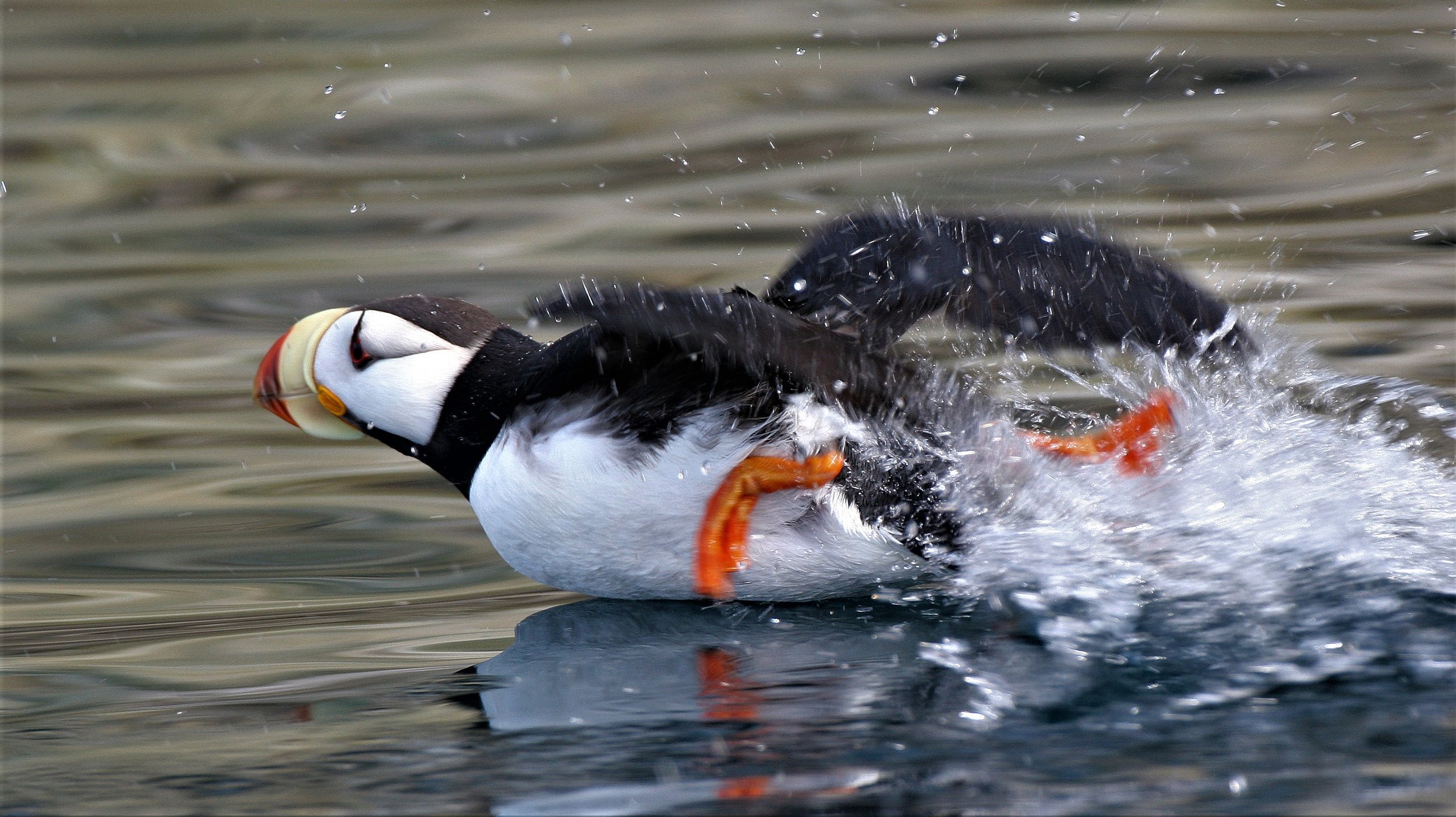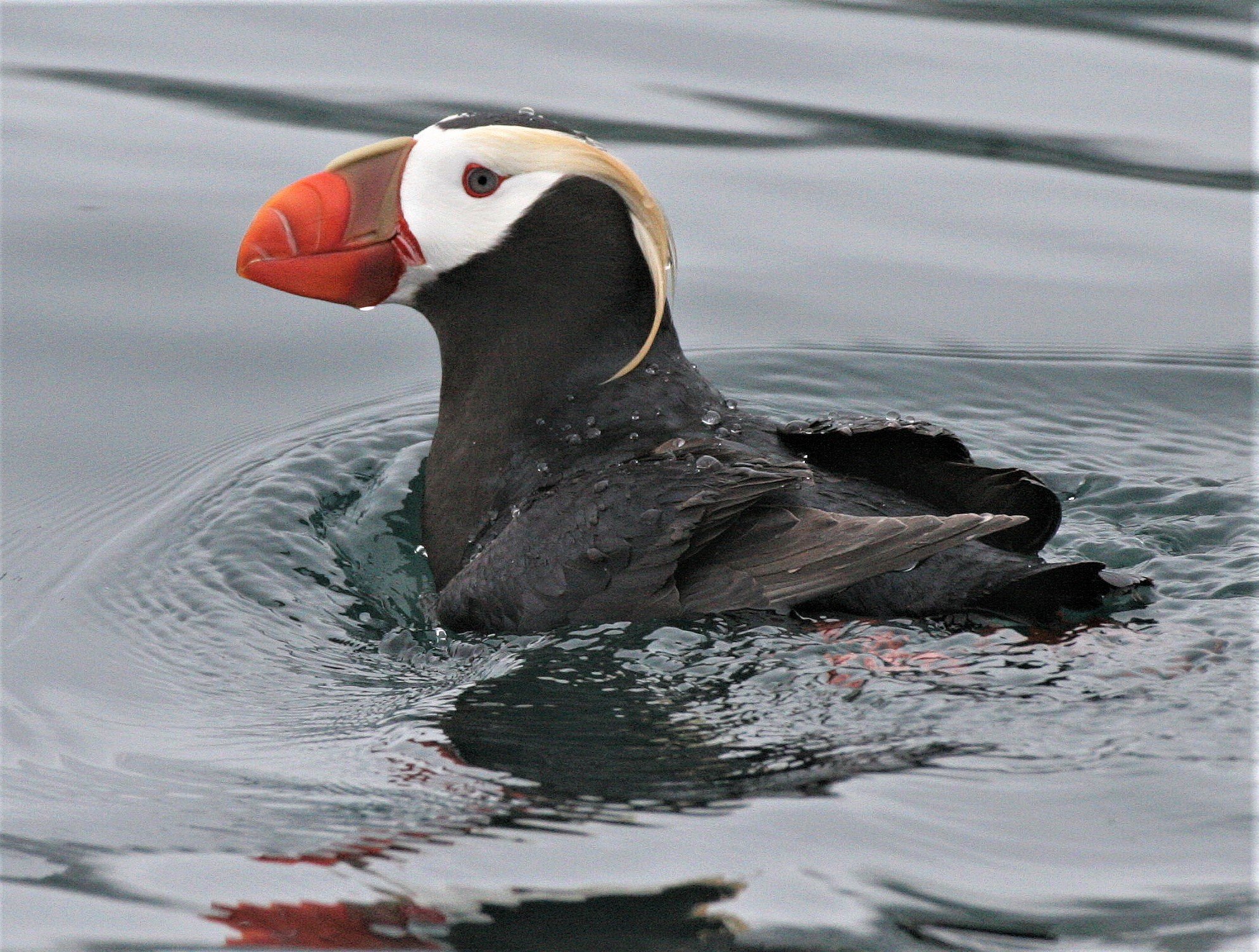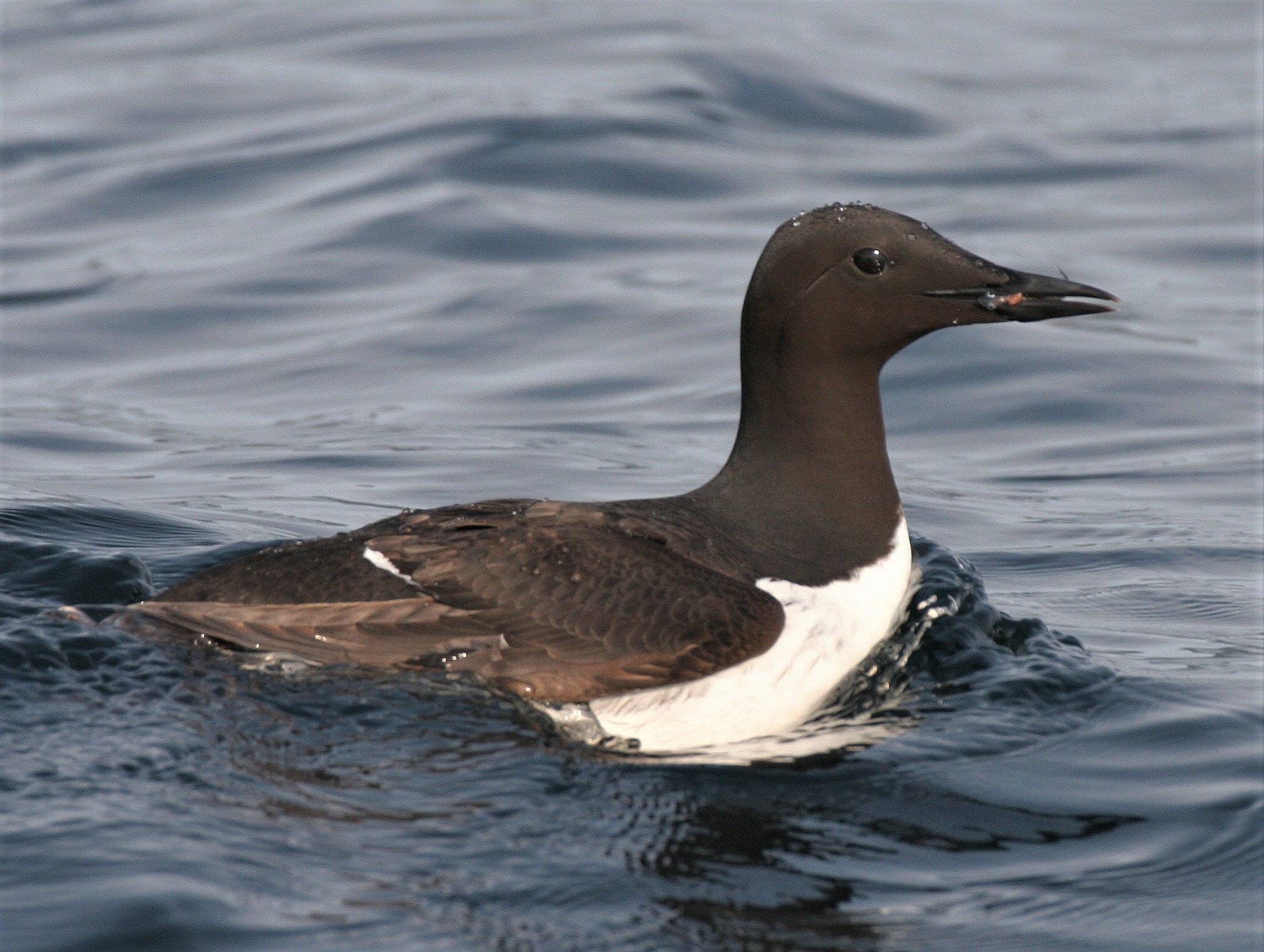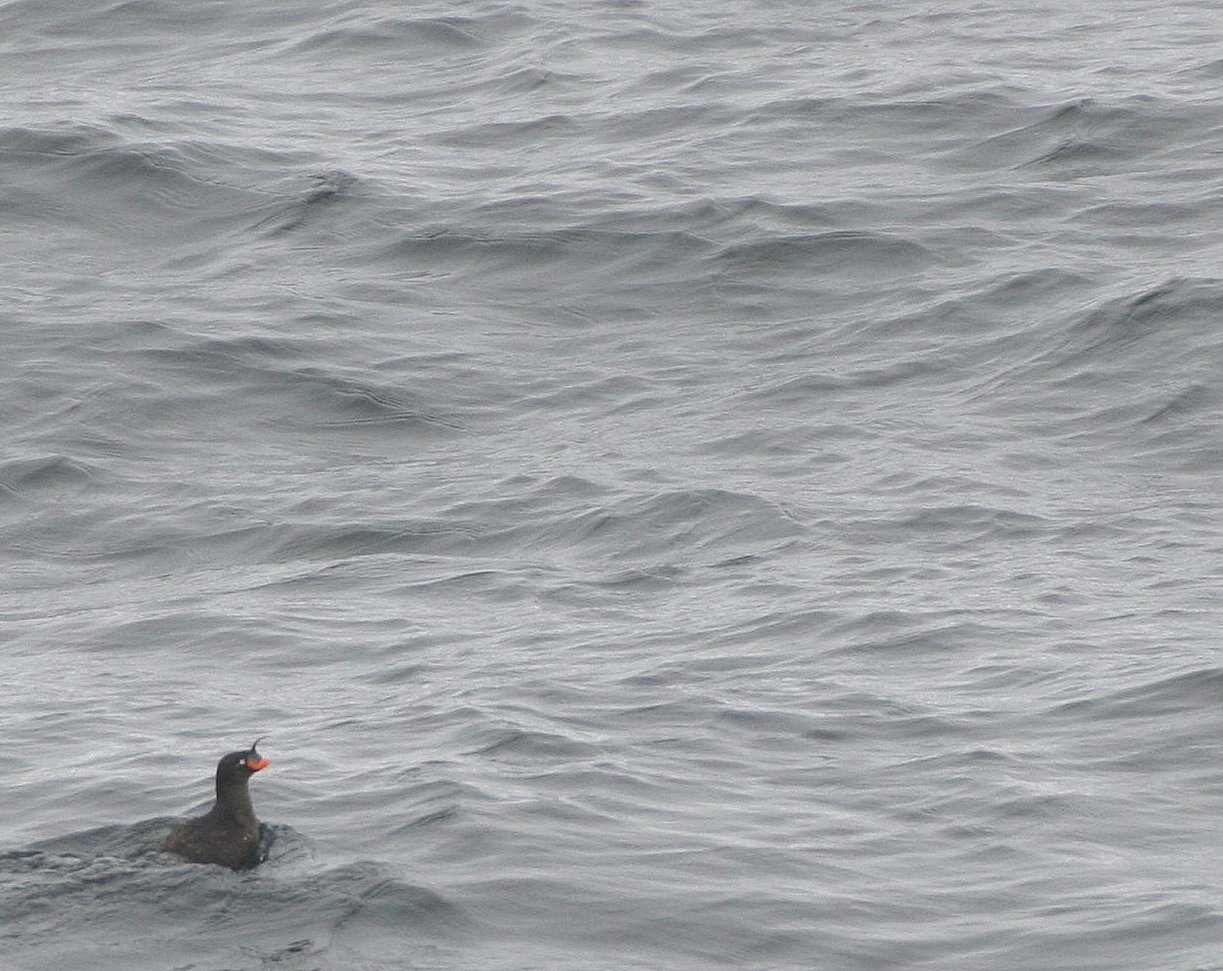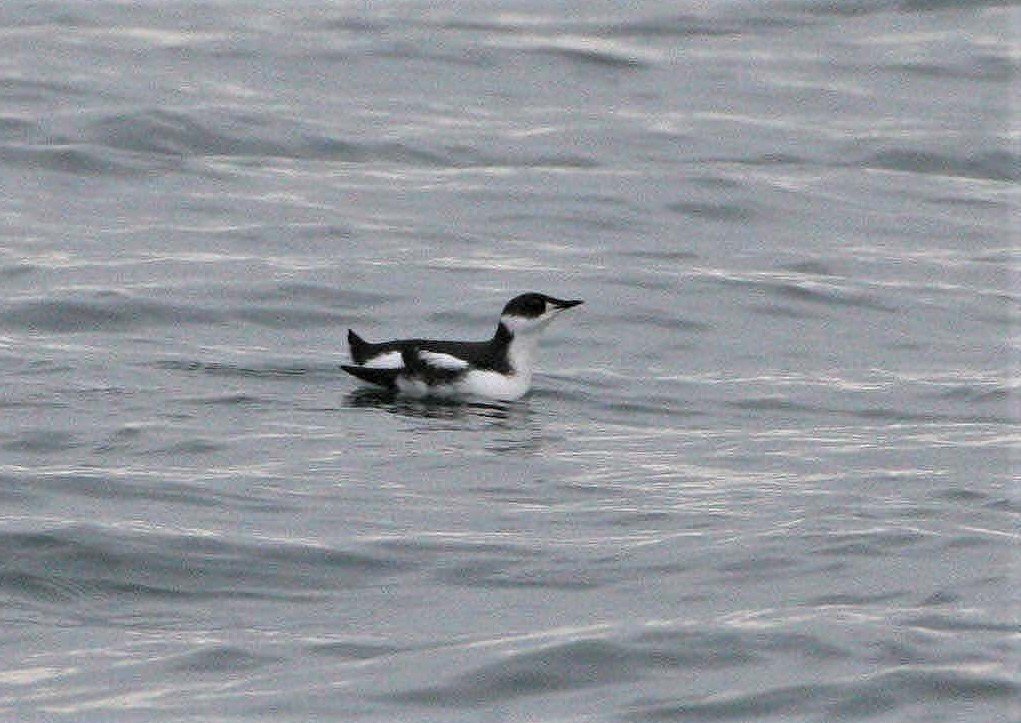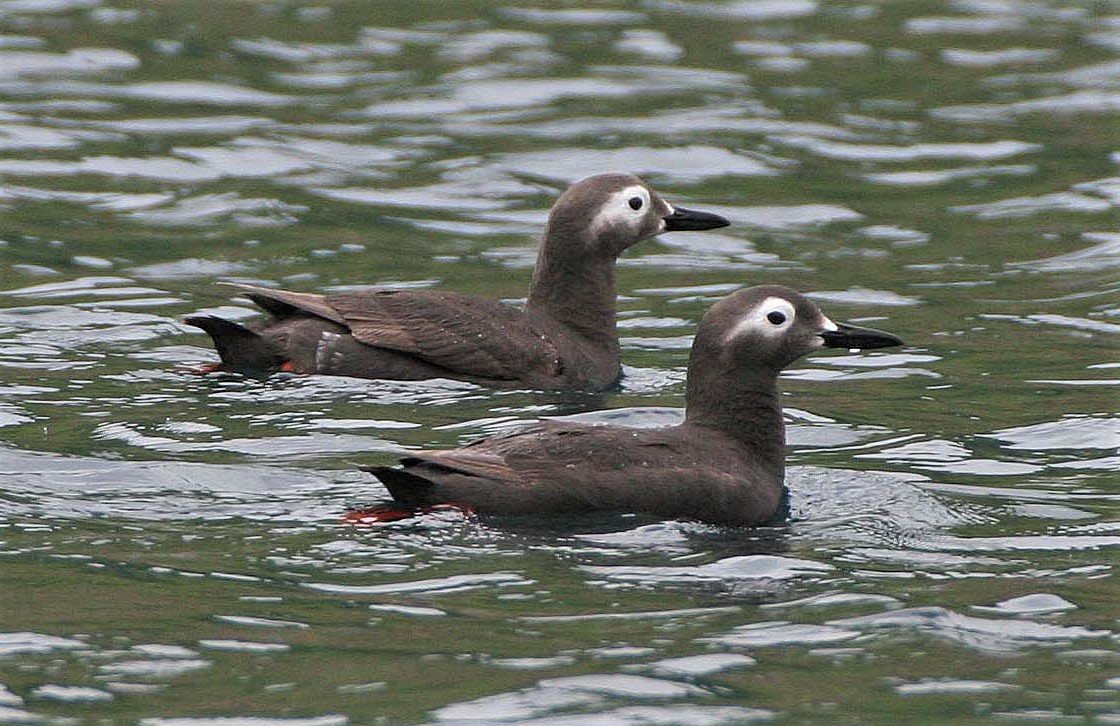
Family Alcidae

An Auk or Alcid is a bird of the family Alcidae in the order Charadriiformes. The alcid family includes the murres, guillemots, auklets, puffins, and murrelets. The family contains 25 extant or recently extinct species that are divided into 11 genera. Apart from the extinct great auk, all auks can fly, and are excellent swimmers (appearing to "fly") and divers, but their walking appears clumsy. Several species have different English names in Europe and North America. The two species known as "murres" in North America are called "guillemots" in Europe, and the species called little auk in Europe is referred to as dovekie in North America.
Horned Puffin in pre-take-off mode in Russia’s Commander Isands
Auks are superficially similar to penguins, having black-and-white colours, upright posture, and some of their habits. Nevertheless, they are not closely related to penguins, but rather are believed to be an example of moderate convergent evolution. Auks are monomorphic (males and females are similar in appearance).
Extant auks range in size from the least auklet, at 85 g (3 oz) and 15 cm (5.9 in), to the thick-billed murre, at 1 kg (2.2 lb) and 45 cm (18 in). Due to their short wings, auks have to flap their wings very quickly to fly.
Although not to the extent of penguins, auks have largely sacrificed flight, and also mobility on land, in exchange for swimming ability; their wings are a compromise between the best possible design for diving and the bare minimum needed for flying. This varies by subfamily, with the Uria guillemots (including the razorbill) and murrelets being the most efficient under the water, whereas the puffins and auklets are better adapted for flying and walking.
The feeding behaviour of auks is often compared to that of penguins; both groups are wing-propelled, pursuit divers. In the region where auks live, their only seabird competition are cormorants (which are dive-powered by their strong feet). In areas where the two groups feed on the same prey, the auks tend to feed further offshore. Strong-swimming murres hunt faster, schooling fish, whereas auklets take slower-moving krill. Time depth recorders on auks have shown that they can dive as deep as 100 m (330 ft) in the case of Uria guillemots, 40 m (130 ft) for the Cepphus guillemots and 30 m (98 ft) for the auklets.
Auks are pelagic birds, spending the majority of their adult lives on the open sea and going ashore only for breeding, although some species, such as the common guillemot, spend a great part of the year defending their nesting spot from others.
Auks are monogamous, and tend to form lifelong pairs. They typically lay a single egg, and they use the nesting site year after year.
Some species, such as the Uria guillemots (murres), nest in large colonies on cliff edges; others, such as the Cepphus guillemots, breed in small groups on rocky coasts; and the puffins, auklets, and some murrelets nest in burrows. All species except the Brachyramphus murrelets are colonial.
Rhino Auklets are my favorite Alcid of all times - this one in Washington’s Juan de Fuca Islands is in full breeding splendor!
The family contains 25 extant or recently extinct species that are divided into 11 genera. The extant auks (subfamily Alcinae) are broken up into two main groups - the usually high-billed puffins (tribe Fraterculini) and auklets (tribe Aethiini), as opposed to the more slender-billed murres and true auks (tribe Alcini), and the murrelets and guillemots (tribes Brachyramphini and Cepphini). The tribal arrangement was originally based on analyses of morphology and ecology. mtDNA cytochrome b sequences, and allozyme studies confirm these findings except that the Synthliboramphus murrelets should be split into a distinct tribe, as they appear more closely related to the Alcini; in any case, assumption of a closer relationship between the former and the true guillemots was only weakly supported by earlier studies.
Of the genera, only a few species are placed in each. This is probably a product of the rather small geographic range of the family (the most limited of any seabird family), and the periods of glacial advance and retreat that have kept the populations on the move in a narrow band of subarctic ocean.
Today, as in the past, the auks are restricted to cooler northern waters. Their ability to spread further south is restricted as their prey hunting method, pursuit diving, becomes less efficient in warmer waters. The speed at which small fish (which along with krill are the auk's principal prey) can swim doubles as the temperature increases from 5 to 15 °C (41 to 59 °F), with no corresponding increase in speed for the bird. The southernmost auks, in California and Mexico, can survive there because of cold upwellings. The current paucity of auks in the Atlantic (six species), compared to the Pacific (19–20 species) is considered to be because of extinctions to the Atlantic auks; the fossil record shows many more species were in the Atlantic during the Pliocene. Auks also tend to be restricted to continental-shelf waters and breed on few oceanic islands.
The below is a taxonomic list of the species that are highlighted in these galleries
Without a doubt one the most spectacular wildlife sightings of my career, the massive “Bird Bazaars” of the Commander Islands, Russia are absolutely incredible. For days we cruised the igneous cliffs of the Commanders searching for the numerous Alcids that find their homes there. With literally millions of individuals on many islands in the Commander-Aleutian Archipelago, the sheer sound and smell of these spectacles is beyond words.
The galleries below represent my luck with a bit over half the species of Alcids on Earth today. There are 13 of the 24 extant species represented below. I would like to think I will see even more species but their sheer remoteness may mean making a serious dent in the remaining species a bit of a pipedream. Who knows!
Subfamily Alcinae
Tribe Alcini – typical auks and murres
The synthliboramphine Xantus's murrelet (Synthliboramphus hypoleucus) is quite distinct from the brachyramphine murrelets.
Uria
Common murre or common guillemot, Uria aalge
Thick-billed murre or, Brünnich's guillemot, Uria lomvia
Tribe Synthliboramphini – synthliboramphine murrelets
Black guillemot (Cepphus grylle, a true guillemot) in summer (front) and winter plumage
Synthliboramphus
Ancient murrelet, Synthliboramphus antiquus
Japanese murrelet, Synthliboramphus wumizusume
Tribe Cepphini – true guillemots
Cepphus
Black guillemot or tystie, Cepphus grylle
Pigeon guillemot, Cepphus columba
Kurile guillemot, Cepphus columba snowi
Spectacled guillemot, Cepphus carbo
Tribe Brachyramphini – brachyramphine murrelets
Brachyramphus
Marbled murrelet, Brachyramphus marmoratus
Subfamily Fraterculinae
Tribe Aethiini – auklets
Aethia
Crested auklet, Aethia cristatella
Whiskered auklet, Aethia pygmaea
Least auklet, Aethia pusilla
Tribe Fraterculini – puffins
Cerorhinca
Rhinoceros auklet, Cerorhinca monocerata
Fratercula
Atlantic puffin, Fratercula arctica
Horned puffin, Fratercula corniculata
Tufted puffin, Fratercula cirrhata

Rhinoceros Auklet (Cerorhinca monocerata) San Juan Islands, Washington
Atlantic Puffin (Fratercula arctica) Svalbard
Tufted Puffin (Fratercula cirrhata) Kamchatka Russia
Horned Puffin (Fratercula corniculata) Commander Islands
Ancient Murrelet (Synthliboramphus antiquus) Kuril Islands, Russia
Common Murre (Uria aalge) West Coast North America
Thick-billed Murre (Uria lomvia eleonorae) Commander Isands

Crested Auklet (Aethia cristatella) Kuril Islands
Least Auklet (Aethia pusilla) Kamchatka Russia
Marbled Murrelet (Brachyramphus marmoratus) Juan de Fuca Islands, Washington
Spectacled Guillemot (Cepphus carbo) Moneron Island, Russia
Pigeon Guillemot (Cepphus columba adiantus) Juan de Fuca Islands, Washington
Black Guillemot (Cepphus grylle mandtii) Svalbard
